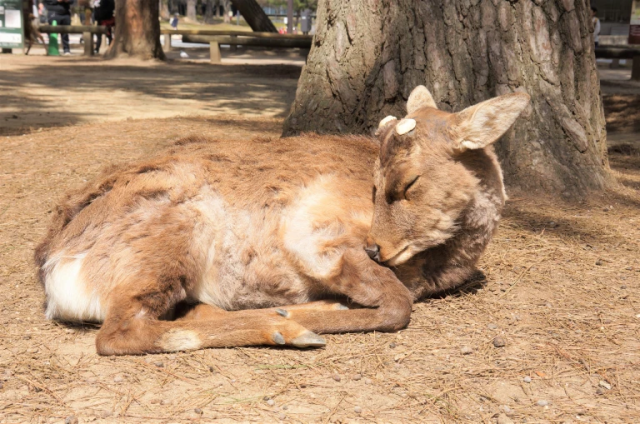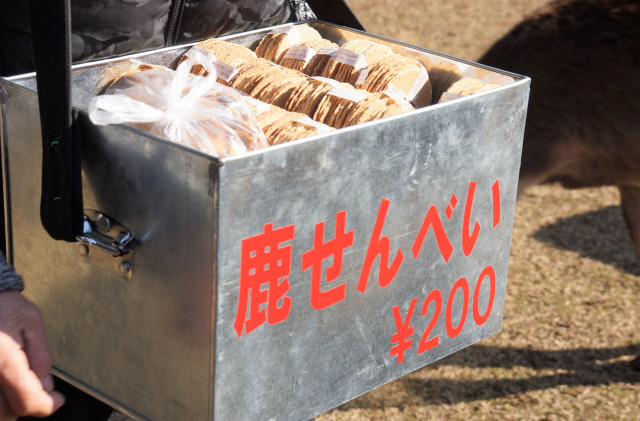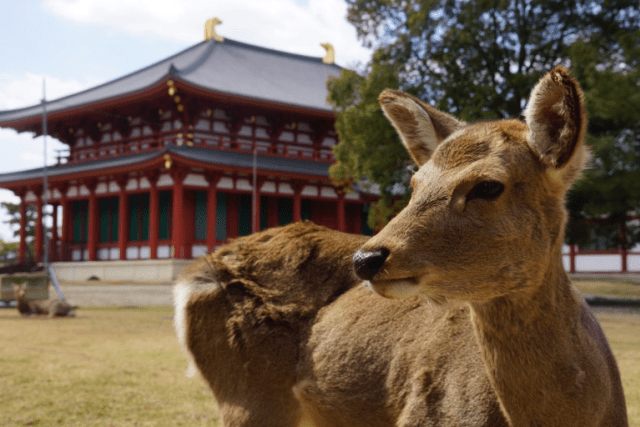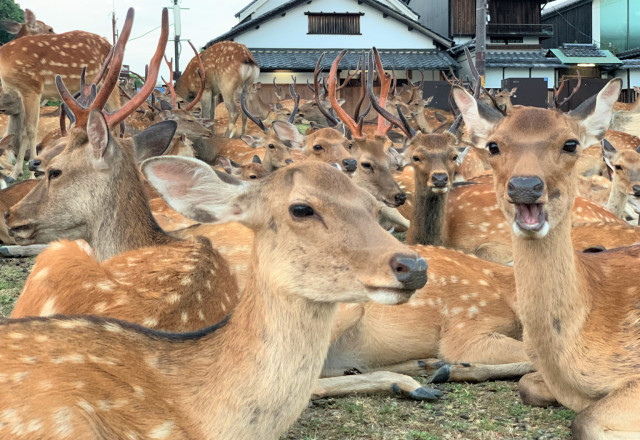
The coronavirus is affecting the health of Japan’s deer population at Nara Park.
The city of Nara in Nara prefecture is famous for its free-roaming deer population, who’ve been known to cross at pedestrian crossings and bow to tourists in Nara Park in return for senbei rice crackers.
The animals’ love for gathering around tourists who feed them rice crackers has been well-documented over the years, but now that the tourists have largely disappeared due to travel restrictions imposed during the coronavirus pandemic, it appears the deer’s dependence on senbei is more serious than first thought.
According to a recent news report, roughly 13 million tourists usually visit Nara Park every year, and the number of rice crackers sold annually amount to approximately 20 million. With around 900 deer living in the park, excluding the 400 that are housed in the “Rokuen” deer shelter, this means each deer usually eats more than 60 rice crackers per day.
▼ Shika Senbei (“Deer Rice Crackers”)
Each senbei weighs about three to four grams (0.1-0.14 ounces) and is considered a snack for the deer, who eat about five kilograms (11 pounds) of grass a day. However, the nutritional value of a rice cracker is higher than grass, making them extremely attractive to the animals. This encourages them to seek out the rice crackers to such an extent that some of the animals are said to have become dependent on them.
While a number of deer have adapted to the decrease in available rice crackers and switched to eating more grass due to the drop in tourists, some of the deer appear to have lost weight and are now roaming further away from the park, pointing to signs of a serious rice cracker dependence.
According to a recent survey conducted by The Nara Deer Preservation Foundation (N.D.P.F.) and Assistant Professor Shirow Tachizawa from Hokkaido University, it was found that the number of deer staying inside the nature-filled environment of Nara Park is decreasing.
In January this year, before the drop in tourists, 71.9 percent of the deer population was recorded in the park during the day, but in June this dropped to 50.2 percent. Nighttime numbers in the park were at 56.5 percent in January and 34.9 percent in June — a roughly 20-percent decrease in both cases.
While the number of deer in Nara Park has decreased, the number of deer sitting on the grass during the day has increased from 19.3 percent to 59.1 percent. Deer, like cows, digest nutrients through a system called rumination, which requires a lot of rest time, so this increase is a good sign as it indicates these deer are eating more grass and returning to a more healthy natural diet.
There have also been signs of improvement in the deer droppings, which have become firmer and darker compared to before the pandemic, when they were often loose. Like humans, deer need less refined food and more natural nourishment to maintain healthy levels of intestinal bacteria.
While a lot of the deer seem to be enjoying improved health without tourists, others are now worryingly thin due to their dependence on rice crackers. Assistant Professor Tachizawa, who specialises in the study of wild animals, believes these deer may have become addicted to senbei.
According to a previous survey, some deer ate more than 200 rice crackers a day, leading the Assistant Professor to speculate that these deer may have become so accustomed to receiving rice crackers that they are now finding it hard to adapt to the changes.
It seems that the coronavirus pandemic is affecting not only the lives of humans, but the lives of the deer at Nara Park as well. Here’s hoping more of the senbei-dependent deer are able to kick their addiction by mimicking the behaviour of their grass-eating relatives as soon as possible.
Otherwise the N.D.P.F. may have to step in to supplement the diet of the deer with more frequent acts of shikayose, the annual calling of the deer with acorns and a French horn.
Source: Sankei Shimbun via Hachima Kikou
Photos © SoraNews24
● Want to hear about SoraNews24’s latest articles as soon as they’re published? Follow us on Facebook and Twitter!






 Nara asks visitors to stop feeding the deer
Nara asks visitors to stop feeding the deer Nara deer leave park, head to station for food as tourist numbers tumble due to coronavirus
Nara deer leave park, head to station for food as tourist numbers tumble due to coronavirus The poo from Nara Park’s deer is changing because of the coronavirus pandemic
The poo from Nara Park’s deer is changing because of the coronavirus pandemic Nara deer shikadamari mystery deepens as tourists return to Nara park
Nara deer shikadamari mystery deepens as tourists return to Nara park Nara deer dies with four kilos of plastic in its stomach, tourists cautioned to feed animals properly
Nara deer dies with four kilos of plastic in its stomach, tourists cautioned to feed animals properly Foreigner’s request for help in Tokyo makes us sad for the state of society
Foreigner’s request for help in Tokyo makes us sad for the state of society Japanese city loses residents’ personal data, which was on paper being transported on a windy day
Japanese city loses residents’ personal data, which was on paper being transported on a windy day Historical figures get manga makeovers from artists of Spy x Family, My Hero Academia and more
Historical figures get manga makeovers from artists of Spy x Family, My Hero Academia and more Akihabara pop-up shop sells goods made by Japanese prison inmates
Akihabara pop-up shop sells goods made by Japanese prison inmates New private rooms on Tokaido Shinkansen change the way we travel from Tokyo to Kyoto
New private rooms on Tokaido Shinkansen change the way we travel from Tokyo to Kyoto Suntory x Super Mario collaboration creates a clever way to transform into Mario【Videos】
Suntory x Super Mario collaboration creates a clever way to transform into Mario【Videos】 Japan’s massive matcha parfait weighs 6 kilos, contains hidden surprises for anyone who eats it
Japan’s massive matcha parfait weighs 6 kilos, contains hidden surprises for anyone who eats it Anime girl English teacher Ellen-sensei becomes VTuber/VVTUber and NFT
Anime girl English teacher Ellen-sensei becomes VTuber/VVTUber and NFT One-of-a-kind Osaka-themed Uniqlo Shinsaibashi opens
One-of-a-kind Osaka-themed Uniqlo Shinsaibashi opens Starbucks Japan adds a Motto Frappuccino to the menu for a limited time
Starbucks Japan adds a Motto Frappuccino to the menu for a limited time McDonald’s new Happy Meals offer up cute and practical Sanrio lifestyle goods
McDonald’s new Happy Meals offer up cute and practical Sanrio lifestyle goods Japanese ramen restaurants under pressure from new yen banknotes
Japanese ramen restaurants under pressure from new yen banknotes French Fries Bread in Tokyo’s Shibuya becomes a hit on social media
French Fries Bread in Tokyo’s Shibuya becomes a hit on social media Studio Ghibli releases new action figures featuring Nausicaä of the Valley of the Wind characters
Studio Ghibli releases new action figures featuring Nausicaä of the Valley of the Wind characters Red light district sushi restaurant in Tokyo shows us just how wrong we were about it
Red light district sushi restaurant in Tokyo shows us just how wrong we were about it Tokyo Tsukiji fish market site to be redeveloped with 50,000-seat stadium, hotel, shopping center
Tokyo Tsukiji fish market site to be redeveloped with 50,000-seat stadium, hotel, shopping center All-you-can-drink Starbucks and amazing views part of Tokyo’s new 170 meter-high sky lounge
All-you-can-drink Starbucks and amazing views part of Tokyo’s new 170 meter-high sky lounge Beautiful Ghibli sealing wax kits let you create accessories and elegant letter decorations【Pics】
Beautiful Ghibli sealing wax kits let you create accessories and elegant letter decorations【Pics】 Studio Ghibli releases Kiki’s Delivery Service chocolate cake pouches in Japan
Studio Ghibli releases Kiki’s Delivery Service chocolate cake pouches in Japan New definition of “Japanese whiskey” goes into effect to prevent fakes from fooling overseas buyers
New definition of “Japanese whiskey” goes into effect to prevent fakes from fooling overseas buyers Our Japanese reporter visits Costco in the U.S., finds super American and very Japanese things
Our Japanese reporter visits Costco in the U.S., finds super American and very Japanese things Studio Ghibli unveils Mother’s Day gift set that captures the love in My Neighbour Totoro
Studio Ghibli unveils Mother’s Day gift set that captures the love in My Neighbour Totoro More foreign tourists than ever before in history visited Japan last month
More foreign tourists than ever before in history visited Japan last month New Pokémon cakes let you eat your way through Pikachu and all the Eevee evolutions
New Pokémon cakes let you eat your way through Pikachu and all the Eevee evolutions Sales of Japan’s most convenient train ticket/shopping payment cards suspended indefinitely
Sales of Japan’s most convenient train ticket/shopping payment cards suspended indefinitely Sold-out Studio Ghibli desktop humidifiers are back so Totoro can help you through the dry season
Sold-out Studio Ghibli desktop humidifiers are back so Totoro can help you through the dry season Japanese government to make first change to romanization spelling rules since the 1950s
Japanese government to make first change to romanization spelling rules since the 1950s Ghibli founders Toshio Suzuki and Hayao Miyazaki contribute to Japanese whisky Totoro label design
Ghibli founders Toshio Suzuki and Hayao Miyazaki contribute to Japanese whisky Totoro label design Doraemon found buried at sea as scene from 1993 anime becomes real life【Photos】
Doraemon found buried at sea as scene from 1993 anime becomes real life【Photos】 Tokyo’s most famous Starbucks is closed
Tokyo’s most famous Starbucks is closed One Piece characters’ nationalities revealed, but fans have mixed opinions
One Piece characters’ nationalities revealed, but fans have mixed opinions We asked a Uniqlo employee what four things we should buy and their suggestions didn’t disappoint
We asked a Uniqlo employee what four things we should buy and their suggestions didn’t disappoint Princesses, fruits, and blacksmiths: Study reveals the 30 most unusual family names in Japan
Princesses, fruits, and blacksmiths: Study reveals the 30 most unusual family names in Japan Nara unveils new vending machines that sell deer crackers
Nara unveils new vending machines that sell deer crackers Deer in Nara Park mysteriously disappear during this year’s shikadamari season
Deer in Nara Park mysteriously disappear during this year’s shikadamari season Deer in Nara Park outnumber visitors, display baffling summer gathering behaviour
Deer in Nara Park outnumber visitors, display baffling summer gathering behaviour Deer killed by man with axe in Nara
Deer killed by man with axe in Nara Nara deer stampede into marathon, hit runner in their path
Nara deer stampede into marathon, hit runner in their path Nara considering increasing number of deer that can be killed each year, expanding culling zone
Nara considering increasing number of deer that can be killed each year, expanding culling zone During Golden Week rush, Nara deer so overwhelmed with rice crackers they wear them as hats
During Golden Week rush, Nara deer so overwhelmed with rice crackers they wear them as hats Adorable bowing deer in Japan shows you can be concurrently cute and courteous【Video】
Adorable bowing deer in Japan shows you can be concurrently cute and courteous【Video】 Nara’s “deer cookie” rice crackers get their first price increase in 28 years
Nara’s “deer cookie” rice crackers get their first price increase in 28 years Nara, Japanese city famous for its streets of tame deer, begins culling program within city
Nara, Japanese city famous for its streets of tame deer, begins culling program within city Why deer are drawn to train tracks, and how Japan is solving the problem with this simple block
Why deer are drawn to train tracks, and how Japan is solving the problem with this simple block Nara Park’s first baby deer of the year has been born, is totally adorable【Video】
Nara Park’s first baby deer of the year has been born, is totally adorable【Video】 Why isn’t there more deer poo in Nara Park? This very strange museum has the answer【Photos】
Why isn’t there more deer poo in Nara Park? This very strange museum has the answer【Photos】 Nara’s deer continue their summertime tradition of commandeering one of the city’s streets
Nara’s deer continue their summertime tradition of commandeering one of the city’s streets Japanese train goes viral for Nara deer decorations
Japanese train goes viral for Nara deer decorations Nara hotel with hot spring baths by imperial palace site is a reason to remember the prefecture
Nara hotel with hot spring baths by imperial palace site is a reason to remember the prefecture “Nara Quest”: The perfect parodying souvenirs from Nara Prefecture for all Dragon Quest fans
“Nara Quest”: The perfect parodying souvenirs from Nara Prefecture for all Dragon Quest fans
Leave a Reply